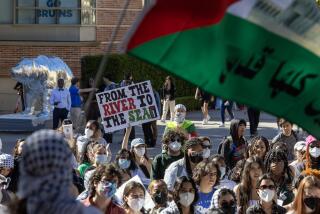In Dispute / SEEKING CREATIVE LOCAL...
- Share via
Your 10-year-old runs in the door crying, “Mommy! Jason called me a ‘dirty Jew.’ He’s going to tell other kids not to play with me.”
Your teen-age daughter comes home from school visibly upset. Someone put racist fliers in all of the African-American students’ lockers.
The neighborhood youth center has been spray-painted with racist graffiti and epithets.
In all three instances, the child has experienced prejudice. The crucial next step is that we, as adults, respond and guide our children well when they share these incidents with us.
As adults, we know rationally that a racial or ethnic epithet hurled at us says more about the attacker than the attacked. But children may not see it that way. Children are particularly vulnerable to feeling left out, different and/or inadequate. The worst thing about bigotry is that it can cause the victim--adult or child--to assume a second-class status. Therefore, it is important that there be some kind of response to these incidents. In most cases, there is no prescribed way to respond to prejudice. Usually, the best response is the one that makes the individual most comfortable. It is within our family units that we must begin discussing appropriate responses to bigotry.
In an effort to help families respond to anti-Semitism, the Anti-Defamation League created “Confronting Anti-Semitism: A Family Awareness Project.” After conducting a survey of Jewish students in public schools, the ADL found that, indeed, these students had been the victim of various anti-Semitic situations. The ADL learned that many of the students did not do anything when confronted.
The most alarming issue to come to light was that most of these students did not tell anyone in authority--a teacher, counselor, principal or parent--when these incidents occurred.
“Confronting Anti-Semitism” is a two-hour workshop for 6th- to 12th-grade students and their parents. It is designed to facilitate communication within Jewish families about issues of anti-Semitism. The starting point is three video vignettes of typical incidents of anti-Semitism followed by a discussion led by a trained facilitator.
During the course of a typical workshop, participants often share stories. Students will tell of incidents they have recently experienced and parents will share some of their own experiences, many of which occurred when they were younger. What is amazing is that this is often the first time that this information has been shared.
As for responding to each incident presented, there is no right or wrong answer. Each incident differs in that the relationship between the perpetrator and the victim varies from friendly to threatening to anonymous. During the workshop, families learn a variety of ways for responding to each incident.
For some it may mean confronting the perpetrator directly and for others it may mean walking away and telling someone in authority. In each instance, the victim must take the situation into consideration. They need to assess how much danger they may be in or the consequences of their response. For instance, if your boss makes an off-color remark, it may be better to speak with him or her privately rather than in front of the whole department.
Providing participants with so many options for response has been the key to the success of the program. Encouraging families to discuss openly how they would respond allows them to learn a variety of options that are available to them.
Prejudice exists in our world today. Whether it’s hurling ethnic epithets or spray-painting racist graffiti, there needs to be some kind of response. We look to the family to provide a sense of pride and well-being for our children. We must also look to our families as one of the places that can provide a safe environment for discussing and responding to prejudicial incidents if they should occur.
More to Read
Sign up for Essential California
The most important California stories and recommendations in your inbox every morning.
You may occasionally receive promotional content from the Los Angeles Times.










